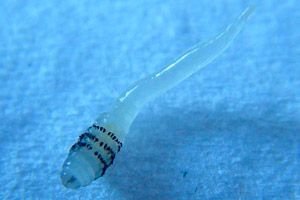
All iLive content is medically reviewed or fact checked to ensure as much factual accuracy as possible.
We have strict sourcing guidelines and only link to reputable media sites, academic research institutions and, whenever possible, medically peer reviewed studies. Note that the numbers in parentheses ([1], [2], etc.) are clickable links to these studies.
If you feel that any of our content is inaccurate, out-of-date, or otherwise questionable, please select it and press Ctrl + Enter.
Dermatobiasis
Medical expert of the article
Last reviewed: 04.07.2025

Dermatobiasis (or South American myiasis) is an obligate myiasis, the development of which is provoked by the larva of the gadfly Dermatobia hominis. A characteristic sign of the disease is the appearance of a purulent node in the skin around the larva growing under the skin.
 [ 1 ]
[ 1 ]
Causes dermatobiasis
The development of South American myiasis is provoked by the larvae of the human gadfly getting on the skin. The female attaches her eggs to the bodies of various insects (such as mosquitoes, ticks, horseflies), and when they land on a person, these larvae detach from the carrier and get under the skin. Dermatobiasis is most common in countries with a tropical climate.
 [ 2 ]
[ 2 ]
Pathogenesis
In dermatobiasis, inflammation in the form of a tumor-like formation is observed on the skin, as well as subcutaneous abscesses with fistulous openings on the surface. The disease manifests itself in the form of a subcutaneous node similar to a carbuncle, 2-3 cm in diameter.
Symptoms dermatobiasis
At the place where the larva penetrated the skin, an abscess appears, which later opens up, forming a hole in the skin through which air will get to the larva. After opening, a purulent-serous fluid is released from the abscess.
Such a larva matures within 2.5 months, growing in the process up to 2.5 cm in length. Pupation usually occurs outside the human body. During the process of "gestation", a person feels a slight pain in the place where the larva is located.
 [ 3 ]
[ 3 ]
Complications and consequences
A complication of the disease may be the development of a secondary infection. In case of development of purulent complications, systemic antibiotics or antimicrobial ointments are used for treatment.
Diagnostics dermatobiasis
Dermatobiasis is diagnosed by studying the patient's epidemiological history. In addition, it is also determined whether the patient has recently been in places where this disease is common. Dermatobiasis is diagnosed based on the clinical picture - after detecting a purulent abscess in the skin, which has an opening. The lesion is carefully examined through a magnifying glass using side lighting. This allows you to detect the movement of larvae in the wound, which are located in colonies.
Differential diagnosis
Differential diagnosis of the disease is carried out with furunculosis.
Who to contact?
Treatment dermatobiasis
Dermatobiasis is treated by removing the larvae from the skin. To do this, the lesion is first washed with disinfectant solutions (this can be furacilin, potassium permanganate, etc.).
To make it easier to remove the larva, a few drops of sterile oil should be dropped into the hole - this will block the parasite's air supply, forcing it to come to the surface. In this case, it will be easy to grab it with a clamp or tweezers and pull it out. The cavity freed from the larva is treated with disinfectants and covered with an aseptic bandage.
Medicines
Modern medicine recommends treatment with the antiparasitic drug ivermectin before the procedure to remove the larva. This is especially necessary if the patient has a concomitant HIV infection.
Ivermectin should be taken before meals, washing down the medicine with plenty of water. It is enough to take 1-2 doses of the drug twice a day with a 1-2-week interval between uses. Upon completion of the treatment course, it is necessary to undergo a mandatory follow-up examination. Side effects of the drug include dizziness and drowsiness, decreased concentration, severe brain disorders, fainting, and a general deterioration in health. Contraindications to the drug include the period of pregnancy planning, bearing a child, and lactation; therapy using medicinal herbs, drugs or dietary supplements; allergic reactions, weak immunity or asthma; when visiting regions with a high risk of infection with non-helminthic diseases.
Folk remedies
In case of dermatobiasis, you can use folk remedies. For example, there is a recipe using birch tar and sulfur. You need to take 4 spoons of tar and mix them with sulfur (6 g) and Vaseline (3 spoons). Apply the resulting ointment to the affected skin.
Prevention
Prevention of the disease consists of observing sanitary and hygienic standards. When in tropical countries, it is necessary to promptly treat ulcers, purulent wounds and abscesses that appear on the body, regularly change bandages and perform sanitary treatment of injuries using antiseptic solutions. It should also be taken into account that carriers of infectious diseases are actively attracted by the smell of pus. When staying in South or Central America, you should use repellents and wear clothes that will help to avoid tick or mosquito bites.
Forecast
Dermatobiasis, if the necessary treatment is started on time, is eliminated quickly and without life-threatening consequences.

